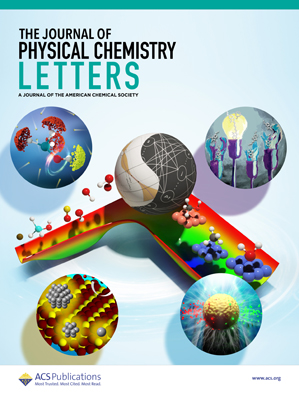利用Mueller矩阵椭偏法揭示胶体量子阱中可调谐的光学各向异性
IF 4.6
2区 化学
Q2 CHEMISTRY, PHYSICAL
引用次数: 0
摘要
胶体量子阱(CQWs)结合了原子级厚度控制和强激子效应,为纳米光子学提供了一个通用的平台。然而,它们的本征光学各向异性尚未得到高精度的定量解析。本研究利用350 ~ 650 nm范围内的Mueller矩阵椭偏光谱技术,发现自组装CdSe CQW单层的双折射(Δnmax≈1.95)和二色性(Δκmax≈1.53)均超过了金红石和黑磷等天然双折射晶体。穆勒矩阵分析揭示了平面内和平面外介电响应之间的显著差异,这是由局限于a-b平面的重空穴激子跃迁和沿c轴的厚度可调量子约束引起的。各向异性从5.5层系统地增强到3.5层,这是由于增加的重孔/轻孔分裂和优先的面内偶极子排列(约97%的面内偶极子排列,经后焦平面成像证实)。这些结果将CdSe CQWs定位为具有巨大厚度可调光学各向异性的可溶液处理平台,为先进的偏振分辨光子研究奠定了基础。本文章由计算机程序翻译,如有差异,请以英文原文为准。

Unraveling Tunable Optical Anisotropy in Colloidal Quantum Wells Using Mueller Matrix Ellipsometry
Colloidal quantum wells (CQWs) combine atomic-level thickness control with strong excitonic effects, offering a versatile platform for nanophotonics. However, their intrinsic optical anisotropy has not been quantitatively resolved with high precision. Here, we employ Mueller matrix spectroscopic ellipsometry over 350–650 nm to reveal record-high birefringence (Δnmax ≈ 1.95) and dichroism (Δκmax ≈ 1.53) in self-assembled CdSe CQW monolayers─values exceeding those of natural birefringent crystals such as rutile and black phosphorus. The Mueller matrix analysis uncovers pronounced differences between in-plane and out-of-plane dielectric responses, arising from heavy-hole exciton transitions confined to the a–b plane and thickness-tunable quantum confinement along the c-axis. The anisotropy strengthens systematically from 5.5 to 3.5 monolayers due to increased heavy-hole/light-hole splitting and preferential in-plane dipole alignment (∼97% in-plane, confirmed by back focal plane imaging). These results position CdSe CQWs as a solution-processable platform with giant, thickness-tunable optical anisotropy, providing a foundation for advanced polarization-resolved photonic studies.
求助全文
通过发布文献求助,成功后即可免费获取论文全文。
去求助
来源期刊

The Journal of Physical Chemistry Letters
CHEMISTRY, PHYSICAL-NANOSCIENCE & NANOTECHNOLOGY
CiteScore
9.60
自引率
7.00%
发文量
1519
审稿时长
1.6 months
期刊介绍:
The Journal of Physical Chemistry (JPC) Letters is devoted to reporting new and original experimental and theoretical basic research of interest to physical chemists, biophysical chemists, chemical physicists, physicists, material scientists, and engineers. An important criterion for acceptance is that the paper reports a significant scientific advance and/or physical insight such that rapid publication is essential. Two issues of JPC Letters are published each month.
 求助内容:
求助内容: 应助结果提醒方式:
应助结果提醒方式:


